New Food Economy: Why can you buy local bread but not local flour?
by Amy Halloran | May 3rd, 2018
Blame America’s commodity grains infrastructure. But a new generation of farmers, bakers, and millers are trying to build a market for what is currently unfeasible: flour with a backstory.
Who doesn’t have a soft spot for their local bakery? There’s nothing like the smell of bread baking as you decide between a cinnamon roll and a croissant. Watching breadmakers shape dough into loaves only increases the appeal, drawing you closer to the way your food is made.
But when it comes to products made with flour, the consumer connection usually ends with the baker. While your baguette might be baked locally, its main ingredient—the wheat flour itself—is likely to be of much more mysterious origin.
When commodity wheat enters the supply chain, a vast network of processing and distribution centers transform the grain kernels and take them far from the fields where they grew. Somewhere along the way, wheat stops being a raw ingredient from somewhere and becomes instead plain old flour—the finely ground, indistinct powder ready to be shipped anywhere in the world. This system was built with volume, price, and convenience in mind. For the most part, transparency has never been a priority—which means, for now, it’s an impossibility as well.
In states like Kansas, wheat dominates the landscape—and yet, strangely, local bushels are extremely hard to come by. But some are trying to create a market for a new kind of locally grown flour with clear, verifiable origins. In part, the effort is an attempt to capitalize on increased interest in regional food with traceable sourcing. But shorter, more transparent routes to market may also represent their best chance for economic survival. After all, wheat farmers earn less than six cents on an average loaf of supermarket bread. Finding ways to differentiate their crops from the sea of anonymous, commodity grain could help growers capture more of that retail dollar.
The stakes are high. As New Food Economy contributor Corie Brown argued last week, much of rural Kansas—a major wheat producing state—is struggling, in large part because of the failed economic promises of large-scale commodity grain. Since hitting recent highs in 2012, wheat, corn, and soy prices fell almost by half, leaving many farmers desperate and deeply leveraged in debt. All over Kansas and other farm states, huge stockpiles sit out unsold; farmers keep holding out as long as they can, hoping prices will rise just a little before they sell.
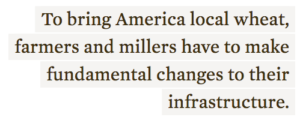 The hope is that origin-verified wheat and other small grains will be desirable enough to command a price premium, giving farmers a better financial bargain. But the question isn’t only whether we’ll pay a little more for flour that’s tracked from seed to plate. To bring America wheat with a history, farmers and millers will have to overcome considerable logistical hurdles—and make fundamental changes to the infrastructure they rely on.
The hope is that origin-verified wheat and other small grains will be desirable enough to command a price premium, giving farmers a better financial bargain. But the question isn’t only whether we’ll pay a little more for flour that’s tracked from seed to plate. To bring America wheat with a history, farmers and millers will have to overcome considerable logistical hurdles—and make fundamental changes to the infrastructure they rely on.
Three generations ago, regional flours from regional mills were the norm in America, not the rarity. But today’s grain system is much more centralized, and industrial milling is the standard. The processing infrastructure, including grain elevators, seed cleaning facilities, and flour mills operate at a vast scale. Bakers have no way to look at the nation’s flood of commodity grain and see a farmer’s face.
That’s why a new generation of bakers is getting into the milling business, building tools and business relationships that allow them to buy wheat directly.
Ibis Bakery, with locations in Lenexa, Kansas and Kansas City, Missouri, is one example. At Black Dog Coffeehouse in Lenexa, waiting in line is more pleasure than chore: There are always samples to snack on, bite-size introductions that take up almost as much room as the pastry case.

Ibis Bakery – Ibis Bakery’s Kansas City location mills its flour in-house. For locally minded bakers, onsite milling has been an empowering solution, but it also has its limitations
“People need to taste it to know it,” says Joel Ball, Ibis’s bread production manager. The company’s brand of bread—rustic looking, naturally leavened, hand-shaped, with mahogany, nearly burnt crusts—is uncommon in the breadbasket, and samples help entice customers into buying what might otherwise be a tough sell.
The newer bakery in Kansas City—inside a former automobile showroom shared with a coffee roaster, Messenger Coffee—goes one step further, milling flour onsite. (Right now, the Lenexa bakery uses different flour sources, while the mill, which opened last October, gets situated.) The coffee roasting and flour milling happen right in front of customers’ eyes. Servers, bakers, baristas and roasters are on hand, ready to answer any questions about the processes on display. And the freshly milled flour is so popular that people want to buy their own sacks to take home, which Ibis plans to let them do very soon.
As it turns out, the added infrastructure that makes truly local bread possible isn’t from the Midwest: The equipment itself comes from New American Stone Mills, a mill-maker in Vermont. The company began when craft bakers Andrew Heyn and Blair Marvin wanted to mill flour for their bakery, Elmore Mountain Bread. Around the country, and as far away as Australia, these 3- to 4-foot wide granite mills have been put to use by a certain stripe of artisan bakery, frequently rooted in urban areas that have a population with extra money for special bread.
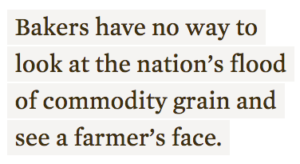 For locally minded bakers, it’s been an empowering solution. But micro-millers and farmers are keenly aware of the solution’s limitations. Grain farms harvest all at once, and traffic in large, whole-field volumes of grain. That’s usually more raw grain than any one micro-bakery can handle—after all, few bakeries are equipped to build grain silos in the back parking lot. A bakery that mills its wheat still lacks the intermediate processing facilities needed, like seed cleaning setups, storage, and distribution hubs.
For locally minded bakers, it’s been an empowering solution. But micro-millers and farmers are keenly aware of the solution’s limitations. Grain farms harvest all at once, and traffic in large, whole-field volumes of grain. That’s usually more raw grain than any one micro-bakery can handle—after all, few bakeries are equipped to build grain silos in the back parking lot. A bakery that mills its wheat still lacks the intermediate processing facilities needed, like seed cleaning setups, storage, and distribution hubs.
“We don’t have the market organized to distribute intermediate quantities,” says Ed Reznicek, manager of Kansas Organic Producers (KOP), a marketing cooperative. KOP members have farms that range from a few hundred acres to a few thousand and the cooperative markets organic wheat, sorghum, millet, and field peas. But since grains are high-volume, low-value crops, even relatively small-scale grain growers still sell in bulk—it’s the only way to make any money. And that means that there’s usually a big gap between what a farmer produces and what a bakery can take on.
Reznicek mentions one KOP member who grew organic Ethiopian blue tinged emmer, a prized specialty grain, and found the amount was too much to send to a little bakery, yet not enough to interest established mills. And so 3,000 bushels—that’s 18,000 pounds, or 9 tons—of high-end heritage grains, enough to satisfy a small city’s demand for local grain for a season, might instead go to feed livestock.
Because of this size discrepancy, most farmers must rely on marketing mechanisms like grain brokers or cooperatives to facilitate the logistics of sales.
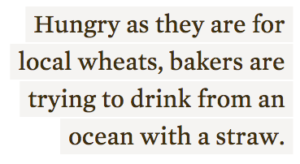 “The members store on-farm, mostly, and the coop arranges sales and shipments,” Reznicek says. This arrangement skews the system towards larger volumes of grain, which are more efficient to pick up and coordinate. “It would cost us as much or more to market a pallet, which is 2,000 pounds,of 50-pound bags of wheat, as it would to market two to three semi-loads.”
“The members store on-farm, mostly, and the coop arranges sales and shipments,” Reznicek says. This arrangement skews the system towards larger volumes of grain, which are more efficient to pick up and coordinate. “It would cost us as much or more to market a pallet, which is 2,000 pounds,of 50-pound bags of wheat, as it would to market two to three semi-loads.”
In theory, producers could sidestep independent distributors. But for those who take on direct marketing, the costs don’t vanish—they increase. Farmers don’t typically have the equipment to clean their wheat to food grade standards, which adds the expense of shipping to a cleaning facility, and shipping back to the farm, or onto the buyer. And they don’t have the marketing budget to sell bakeries on specific heritage varieties. All this means that some micro-bakeries—even when they have the desired crops nearby—end up buying everyday grain belt wheat.
It’s a peculiar problem. The emerging market for heritage and source-verified grains doesn’t really have a supply bottleneck, nor is there a lack of consumer demand. Instead, the missing piece is infrastructure for the wholesale buyer. Hungry as they are for local wheats, bakers are trying to drink from an ocean with a straw.
One solution may be for large-scale mills themselves to adapt to changing times. Farmer Direct Foods, a cooperative and custom mill founded in 1988, may hold the key to large-scale artisan grain production: Its facility has been built with transparency in mind.
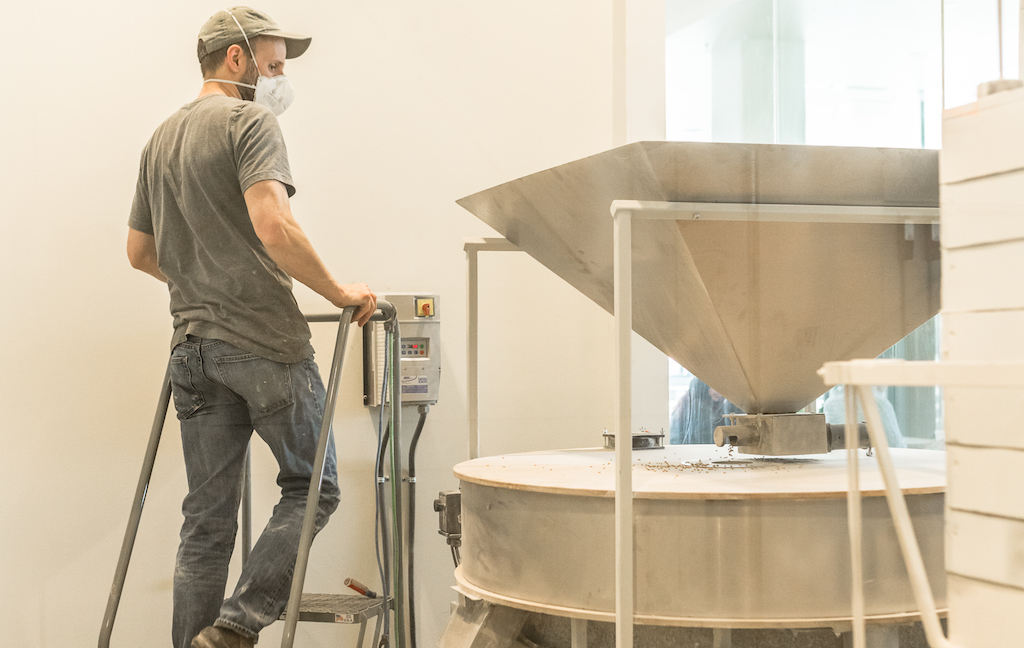
Ibis Bakery – Micro-bakeries—even though they have the infrastructure to buy locally—end up buying everyday grain belt wheat because farmers usually can’t afford to sidestep distributors
“We knew that there were desirable wheat lines available but they’d never have identity of their own,” says Kent Symns, who served as president of the cooperative from its beginning until his retirement, in 2015. Rather than grow crops that would, as he said, just become part of a river of good grain, the Farmer Direct members put together a system based on certified seed production. As a result, the emphasis isn’t just on feeding more grain into a larger river. It’s about finding ways to highlight what makes each tributary special, using those unusual characteristics to create value.
This makes extra work for each grower, who has to fill out a detailed spec sheet, noting which certified seed type is planted, one of three to five varieties of hard white wheat. White means the bran is white colored rather than red; hard means the grain has gluten-forming capacities better for bread than pastry applications. One type is called Baker’s White, another Tiger. Both are modern breeding lines, not revered heritage ones.
The sheets detail farm practices: irrigation methods, approach to tillage, and, most notably, whether glyphosate was used prior to harvest. For sustainability purposes, Farmer Direct growers rotate their crops and plant ground covers during a fallow year to reduce soil erosion and put nitrogen back in the soil naturally.
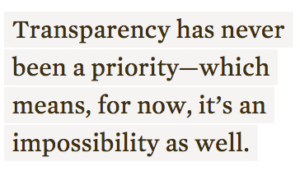 These kinds of farming practices, as well as an Identity Assurance program, have been a selling point for one of the mill’s biggest customers, King Arthur Flour. The New England-based company uses Farmer Direct as one of the custom mills for its stone ground white whole wheat flour—differentiated in supermarkets by an orange and tan bag, with a “FIELD to FLOUR” label next to the brand’s familiar knight on horseback. A smaller font notes that this is “identity-preserved wheat” grown using sustainable farming practices; the back of the bag contains a list of appealing terms like transparency and sustainability, naming examples like traceability, certified seed, and no-till practices.
These kinds of farming practices, as well as an Identity Assurance program, have been a selling point for one of the mill’s biggest customers, King Arthur Flour. The New England-based company uses Farmer Direct as one of the custom mills for its stone ground white whole wheat flour—differentiated in supermarkets by an orange and tan bag, with a “FIELD to FLOUR” label next to the brand’s familiar knight on horseback. A smaller font notes that this is “identity-preserved wheat” grown using sustainable farming practices; the back of the bag contains a list of appealing terms like transparency and sustainability, naming examples like traceability, certified seed, and no-till practices.
“Internally we can look at the lot code and find out what farmer grew the wheat in the bag,” says Bill Tine, vice president of marketing at King Arthur Flour. For the moment, traceability that is consumer-facing is not provided—industry studies suggest that, for now, most Americans shrug when given the ability to track their goods by product code. Still, the wheat carries other properties that seem to have resonated. For example: “To have a conventional wheat that restricts use of glyphosate is unique,” says Tine.
King Arthur has a seat on the board of Farmer Direct, and the company’s president, Bob Morando, hopes to see the mill expand. A graduate of Kansas State’s Milling Science Program—the only four-year program in milling in America, a clear indicator of how consolidated the milling industry has become—he has decades of expertise to apply. Currently Farmer Direct is not processing at full capacity, but Morando says he’s optimistic about growth: Assets like seed cleaning equipment, four stone mills, and a robotic bagging system are an opportunity for the company to take advantage of its infrastructure and handle even more specialty varieties at scale.
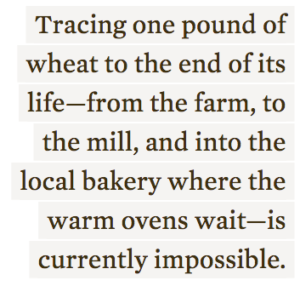 Farmer Direct’s last product expansion went beyond the cooperative’s own identity-preserved white wheat. Its new Pride of the Prairie brand features red wheat as well as white, and an “Heirloom Blend” that combines Turkey Red and Scout wheats. These flours are available online and in a handful of Kansas stores, a quiet success that downplays the enormous effort involved—and the amount of work left to do if the business is to expand.
Farmer Direct’s last product expansion went beyond the cooperative’s own identity-preserved white wheat. Its new Pride of the Prairie brand features red wheat as well as white, and an “Heirloom Blend” that combines Turkey Red and Scout wheats. These flours are available online and in a handful of Kansas stores, a quiet success that downplays the enormous effort involved—and the amount of work left to do if the business is to expand.
In Kansas, nine million of the state’s 16,000,000 acres in cropland are wheat. That’s 330,000,000 bushels of grain—and since each bushel weighs about 60 pounds, this makes about 20,000,000,000 pounds of grain. At this scale, tracing just one pound from the farm to the mill, and then into the local bakery where the warm ovens wait—is currently impossible. But achieving that kind of transparency with local beef might have once seemed ridiculous, too.
For Ibis, finding small-scale grains to mill was so tough that the company turned to an unusual partner: its egg supplier, in Sweet Springs, Missouri. Today, 180 Degree Farm grows 80 acres of wheat for Ibis. In a couple of months, the crop will begin to make its way to Kansas City, where the mill will transform it into flour with a history. Nearby growers have caught wind, says Ibis owner Chris Matsch, and are looking for ways to satisfy the appetite for regional grains. Ideas about cooperative seed cleaning and a storage/distribution hub are now circulating. Hopefully, a new story is just beginning.
